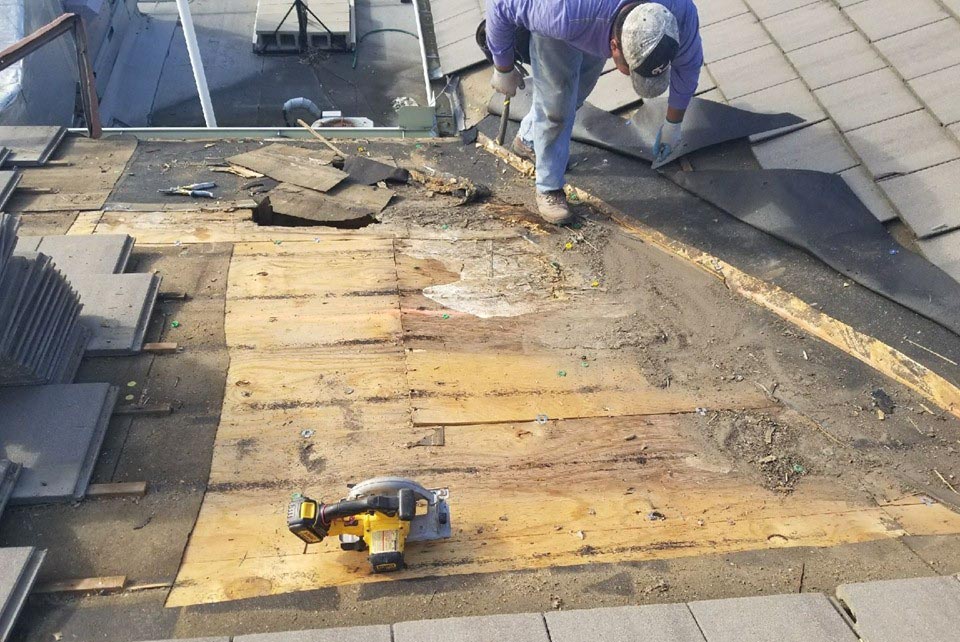A house exterior made with high-performance materials is a great source of comfort for homeowners. Not only are modern, premium windows, siding, and roofing great investments that make your home and property look amazing, they’re also preventative measures that protect your household from outside threats and the weather.
Naturally, your home’s first line of defense against the outside world is the roof over our heads. Fortunately, high-quality roof constructions are made to last throughout any kind of weather, rain or shine. However, in Kansas City, severe storms and erratic weather patterns can chip away at the natural defenses of the roof, which could result in significant and costly storm damage for homeowners.
For this reason, it’s important to understand the signs of storm damage and how to spot them. In this article, your expert team at Smart Exteriors will reveal some of the most damaging storm types and the typical roof problems they inflict on homes in the Midwest. We’ll also go over how to spot these issues, and why it’s so important to contact your professional roofing team to fix any issues as soon as they’re detected.
Signs of Storm Damage
When the condition of your roof is compromised, a lot of the signs such as loose or missing shingles are fairly obvious. However, certain kinds of storms cause specific damage to the roof structures. Here are some examples of what to look out for after specific types of inclement weather:
- Wind Damage: Most storms come with high wind speeds. This results in numerous problems such as uprooted trees, broken windows, and a compromised roof. When it comes to the roof, the key is to inspect for missing or cracked shingles, tears in the flashing, and dents from impacts from falling debris throughout the roof and gutter system.
- Water Damage: Most heavy storms involve water. Water can cause various issues, including damage caused by pooling water due to missing shingles. Water damage is harder to detect since water seeps into the home’s foundation and structure. That’s why it’s important to check for common signs such as water buildup, water spots on the ceilings, mold in the attic, or any sign of rot. Water damage is a serious problem that requires immediate attention due to its potential to cause additional damage over time.
- Hail Damage: Hail damage is possibly the easiest type of roof damage to identify. Combined with high wind speeds, hail can be severe enough to cause cracked or broken shingles/tiles, dented gutters and downspouts, and even holes in the roof itself. After a hailstorm, always check your roof for signs of damage and have any issues fixed immediately.
- Freezing Temperatures: While ice dams aren’t always a direct result of storms, they can be an after-effect caused by fluctuating temperatures and a heavy freeze/thaw cycle. After a freeze, look for signs of ice dams. These can include icicles hanging from the roof edges (with water trapped behind them), brown or “dirty water” icicle formations, water stains and moisture spots on your attic or ceiling walls, or gutters that aren’t draining water properly.
Different Storms Cause Different Problems
Before you begin your roof inspection after a major storm, the job can be made much easier by understanding what type of damage to expect. This can be accomplished by knowing the most common storms to affect residents in Kansas City.
- Thunderstorms: This type of storm is what’s considered an equal opportunity storm. Everything from hard rain to high wind speeds can be included in a thunderstorm. Lightning strikes can be a concern, and in some cases, hail damage, too. In most cases, damage from high winds and water damage are the largest concerns with this type of storm. However, take care when inspecting after a thunderstorm since the roof structure can be weakened in certain conditions.
- Ice Storms: The Midwest is known for its ice storms during the winter months. This type of storm shows itself as freezing rain that leaves behind a thick covering of ice over everything, including the roof. In addition to power outages, ice storms can put pressure on the roof and cause water damage if the melting process is slow. Depending on the circumstances, ice dams are a common side effect of ice storms.
- Tornadoes: Residents of the Kansas City area are quite familiar with tornadoes thanks to Missouri’s status as being part of Tornado Alley. The most severe problem homeowners face is high wind speeds. Tornadoes can rev up to 300 MPH wind speeds, which can strip entire layers or more off the roof. Inspection after a tornado should be done from the ground or with the assistance of a professional.
- Blizzards: Blizzards are a hallmark of Midwest winters. They bring a combination of heavy snowfall and high winds, which equals significant damage to the roof. Plus, the accumulated weight of heavy snow can result in roof collapse if not melted quickly enough. Also, the snow that refreezes and thaws in rapid successions can result in ice dams forming as well.
- Hailstorms: While hail can accompany thunderstorms, it can also strike on its own. This is much worse since the quantity of hailstones is much higher. They’re also usually bigger, which results in greater impacts on the roof. The repeated impacts on the roof can cause dents and holes to form, which is why extreme care should be taken when inspecting after a hailstorm.
What to Do After Spotting Roof Damage
At this point, you know what types of storms cause which types of damage. Whether you or a roofing contractor has done the inspection, there are two crucial steps to take upon discovering storm damage on your rooftop.
- Contact the insurance provider: Damage to the roof or other parts of the home are often covered by home insurance. As such, it’s critical to begin the insurance claims process as soon as possible when damage is discovered. Most homeowners aren’t prepared to take on the cost of a new roof, which is why insurance is so handy. The longer you delay in getting assistance, the more likely the claim will be denied.
- Hire a roofing contractor: Repairing or replacing the roof after storm damage is not a DIY task. This is one of those situations where you need the help of professionals. Make sure when choosing your roofing company, you choose one that’s experienced in correcting storm damage. Qualities to look for include making sure they understand how to identify and correct water damage and have a trustworthy reputation among other qualifications.
Ready to have your Kansas City home inspected for roof damage after a storm? Give us a call at Smart Exteriors to speak with one of our agents about our roofing services now, or fill out our online form to schedule your free, in-home assessment.

